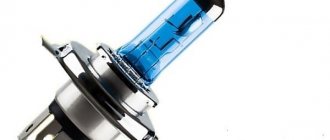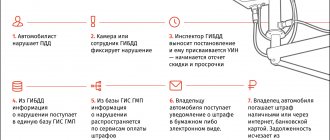Everyone's driving experience is different. Some have been turning the steering wheel for decades, while others only recently received their license. But, be that as it may, sitting behind the wheel of a car in the dark, everyone wants to see further and more. Bright light and the maximum possible viewing angle will allow you to navigate the road in time.
How do drivers solve this problem? Differently. Some of them simply try not to drive at night. The latter make sure that their car produces more powerful light. To do this, they install xenon bulbs.
These light sources not only allow you to see perfectly in the dark, but also look very impressive. However, a traffic police officer can issue a fine for xenon, which is undesirable for any driver. That is why it is necessary to study all the negative and positive aspects of using such light bulbs and clearly know the responsibility of the car owner using them.
Positive aspects and history of application
Xenon emits light that is close in its characteristics to daylight. This is why it becomes much easier for the driver to distinguish objects at night. The person driving is not afraid of bad weather conditions. Xenon light is able to pass through drops of fog or rain, perfectly illuminating the road surface. This protects the driver's eyes from unnecessary strain. In addition, xenon light creates a wider beam. And this ability allows him to better see those objects that are on the sidelines.
Xenon lamps are durable. Their service life ranges from 2800 to 3000 hours (for halogen ones - 180-500 hours).
Xenon gas-discharge lamps began to be installed in cars back in 1992. They differed favorably from halogen lamps in their greater light output and low energy consumption.
Revocation of a driver's license for xenon fog lights
The requirements for fog lighting devices correspond to those for the main headlights. If the vehicle design does not provide for the installation of gas-discharge lamps in fog lighting devices, the driver may be deprived of his license for xenon in fog lights for a period of 6 to 12 months.
You need to know what type of lamps are provided by the car manufacturer. The following symbols exist: • DC – installation of gas-discharge lamps is permitted only for low-beam headlights; • DR – xenon lamps can be used for high beam; • DCR - gas discharge lamps can be used for low beam or high beam headlights at the same time.
The type of headlights can be determined by the sign in the form of a circle, inside of which there is the letter “E”. It is followed by the country number and headlight approval code. If xenon lamps are used in conventional or fog lamps that are not designed to install xenon light, the operating mode of the headlights is considered inconsistent with the required one. Therefore, deprivation of rights for xenon becomes legal.
Self-installation of xenon
Any car enthusiast can purchase such light bulbs without much difficulty. This product, usually made in China, is offered in all markets selling spare parts. Some car enthusiasts purchase such bulbs so that the headlights of their car provide brighter light in the dark, while others strive to give their “iron horse” a more impressive look.
However, everything is not so simple. A car equipped with such a light begins to look somewhat provincial, and on the road the police are constantly trying to stop the driver in order to issue a fine for xenon. Why is everything happening like this? The answer is quite simple. It is not enough to install one xenon. Car headlights must be equipped with washer nozzles, and in addition, to form the correct luminous flux, a special corrector is required. In the absence of such equipment, you will definitely receive a fine for xenon installed without permission.
There is one more nuance. Your vehicle's headlights should be marked with symbols such as DCDR or DCR. If they are not, then you will also receive a fine for installing xenon. There are cars with DC/HR markings on their headlights. They can be equipped with gas discharge bulbs as a source of low beam only.
How to pass MOT
When passing the next technical inspection, a specialist will easily establish the legality of your light. After all, starting from 2021, special attention is paid to lighting devices.
The technician will check both the headlights and fog lights. And if there are inconsistencies, then the technical inspection will not be passed. The car will not be allowed to be used. A service station employee will not issue a fine for xenon in 2021. And it is not his responsibility to call a traffic police officer to record a violation. But the driver will need to fix the problem, including dismantling the xenon and installing a factory light fixture.
However, if the technician detects xenon light only in the rear lights (reversing light), then the dilemma of which xenon is allowed and which is not will not arise. Problems can only arise with the so-called front light.
Negative sides of xenon
Why does the traffic police impose fines for installing brighter lamps in a car? The fact is that such light blinds oncoming drivers and those driving ahead.
Car owners who decide to install xenon also encounter problems. Such lamps are quite difficult to adjust. In addition, the computers of modern cars do not perceive them as a working element of the circuit, diagnosing a malfunction.
If the headlight is designed for a halogen lamp, then installing xenon may result in flickering light. This mode quickly tires the driver's eyes.
Taking into account the fact that blinding bright light can create an emergency situation on the road, in the legislation of the Russian Federation there is administrative responsibility that allows the traffic police to issue fines for the use of external lighting devices by the car owner that were not originally provided for in the design of the vehicle.
Why is deprivation of rights for xenon illegal?
The installation of xenon on cars unsuitable for this is brought under part three of Article 12.5 of the Administrative Code. This article provides for deprivation of rights for up to a year with confiscation of installed equipment. However, the problem is that the article itself does not say a word about xenon. It says that rights are deprived for the installation of lighting devices that have a color and operating mode that does not comply with the requirements of the law.
In fact, an unregistered xenon installation should be punishable by a fine of 500 rubles. or even a warning under the first part of the same article 12.5 of the Code of Administrative Offences. It is this article that establishes sanctions for drivers of cars with defects.
Amendments to the Code of Administrative Offenses
Since 2012, traffic police officers began to pay attention to which lamps in the headlights of moving cars illuminate the road for drivers. Such actions were due to the introduction of some changes to the Administrative Code. Art. 12.4 and 12.5 of this code began to indicate that only those lamps should be installed in cars that comply with the “Basic Rules for the Operation and Approval of Vehicles” and also do not conflict with GOST. These documents also apply to xenon. They allow its installation only if it is provided for by the car manufacturer.
The Code of Administrative Offenses provided for a fine for xenon in fog lights if the car owner independently changed the design of his car. The citizen had to pay 2.5 thousand rubles and part with the lighting devices. A larger fine was imposed on the company’s transport – from 15 to 20 thousand rubles. As for the individual entrepreneur, they charged from 400 to 500 thousand rubles for installing xenon.
Article for using improper lighting fixtures
Article No. 12-5 of the Code of Administrative Offenses of the Russian Federation (Part 3) determines that drivers who drive a vehicle with installed external lighting devices that do not correspond to the factory design, including xenon, should be deprived of their rights for a period of 6 months to 1 year.
There is also a regulation that provides for a fine for the use of improper lighting devices. We are talking about Part 1 of Article 12-4 of the Code of Administrative Offenses, which states that persons who have installed retro-reflective elements with a red color effect in their vehicle can be fined in the amount of 3 thousand to 500 thousand rubles (officials - up to 20 thousand. rubles, the maximum amount is for legal entities).
A traffic police officer has the right to apply two articles to a violator at once. The driver will be required to pay a fine and will have his driving license revoked.
The need for a ban
Traffic police fines for xenon have left many motorists bewildered. Why punish for installing more efficient light sources? However, there are quite a lot of arguments for the application of this law.
For those who were outraged by the innovation, it is worth saying that xenon cannot always improve visibility on the road. Headlights of older car models are not able to create the necessary beam of light. In addition, the owner of a converted car has to solve a large number of problems. Among them: - lack of concentration of light beams over a long distance, which allows you to see only nearby objects; — poor quality xenon made in China.
All this, as well as the creation of an emergency situation due to blinding bright light, made it necessary to prohibit the independent installation of overly bright lamps.
Is xenon banned in Russia?
Gas discharge lamps in headlights and fog lights (fog lights) are permitted according to Russian legislation.
However, the Explanation of the Ministry of Internal Affairs of the Russian Federation “On the use of xenon headlights” limits the use of this lighting equipment.
The document states that headlights intended for xenon are designated DR, DC, DCR. A mandatory requirement is the presence of an automatic corrector and washer.
These features are reflected in the machine’s operating instructions and the manufacturer’s certificate. If the design of the vehicle includes gas-discharge lamps, traffic police inspectors will not have any questions for the owner.
Administrative liability arises for equipping a vehicle with lighting devices not provided for by the manufacturer and design. Headlights marked HR, HC, HCR must use only halogen light sources. Markings R, C, CR are designed for installation of incandescent lamps.
Opinion of road users
It’s too late to talk about the legality of the innovations in the Administrative Code. Changes have been made to the Code, and we have to put up with it. However, there is still no unity on this issue. Some drivers completely agree with such a harsh punishment. They explain their position by the fact that bright xenon light often becomes the culprit in creating emergency situations on the road. There are other opinions. There are drivers who are convinced that the bright xenon light helps them notice a pedestrian or a dangerous hole on the road at night in time, thereby preventing a possible accident. Of course, both sides have weighty arguments.
Why do the courts deprive people of their rights for xenon?
Why do inspectors draw up protocols on the third part of the article? And why do the courts confirm the legality of such a decision? The thing is that xenon headlights differ from halogen headlights in their operating principle. And the judges can call this a non-compliance with the operating mode, since in the Basic Provisions, to which Article 12.5 refers, there is no clear definition of the operating modes of the headlights.
However, there is another piece of legislation that still explains what the “mode of operation of lighting devices” is. This document is TR CU “On the safety of wheeled vehicles.” It sets 2 modes of headlight operation: constant and flashing. And according to this criterion, halogen and xenon headlights do not differ from each other. Based on this, it can be argued that even the illegal installation of xenon does not violate Part 3 of Article 12.5.
Visual inspection
How to avoid a fine for xenon in the form of deprivation of rights? First of all, it is necessary to understand how a traffic police officer can visually determine whether lighting devices comply with technical regulations. In road conditions, this can only be done by markings on the body or glass of the headlights. If the design feature of the car allows only halogen lamps to be installed on it, then we can see the symbol H. For xenon headlights there is a designation D. It happens that there are no markings on the lighting devices at all. This indicates that the headlights are designed for conventional incandescent lamps.
As a rule, the traffic police inspector is limited to checking the markings. He simply does not have the necessary authority for other actions. This benefits many drivers. They use stickers that indicate the xenon type of headlight. Such dodgers simply erase the old markings. Of course, the issue can be resolved this way. However, this is very dangerous. If the traffic police inspector identifies this trick, then it will not be possible to escape punishment.
Cancellation (termination) of registration for xenon
In recent years, the traffic police has been practicing such a form of punishment as deregistration of a car for non-compliance with its technical regulations. Most often, the practice of deregistration can be found for installing LPG (converting a car to gas), a firewall, and the like - the main thing for this is that the car has been converted. Installing xenon, if xenon is not provided by the manufacturer, is a re-equipment of the car, since a component is installed on it that does not meet the safety level tested for this car model.
Consequently, car registration can be canceled for xenon. How does this happen? Most often, you simply receive a notification by mail from the traffic police stating that the registration of your car has been terminated due to the installation of xenon. Before this, of course, you should have been caught with xenon (and, most likely, more than once). Also with the notice you will receive a requirement to present the car for inspection at the traffic police - just as if you brought the car in for inspection when purchasing it for registration.
If you do not do this, then when your documents are searched through the database by the traffic police officer who once stopped you and sees the termination of registration, for the first time he will issue a fine in the amount of 500 rubles under Part 1 of Article 12.1 of the Administrative Code. The second time you will face a fine of 5,000 rubles or deprivation of your license for 1-3 months. At the same time, your registration certificate (pink plastic) and license plate number will be confiscated from you.
Alas, but cancellation of registration in essence, although absurd, is quite legal. This right is given by paragraph 50 of Order No. 399 “On the procedure for registering vehicles.”
Legal ways to solve the problem
You can avoid punishment in the form of deprivation of your rights and provide yourself with bright light at night in another, simpler, but not cheaper way. It involves installing legal xenon headlights on the car. There will be a D mark on their body, indicating the legality of bright lamps.
However, not many owners will be able to afford such a conversion of their “iron horse”. In addition, there are car models for which it is impossible to find standard xenon. In this case, tuning headlights equipped with lens modules will help solve the problem. It is in them that you can install xenon lamps with a glow temperature not exceeding 4300 K. This is a wonderful option. It will allow the light to maintain the necessary power and the color to be similar to halogen. It is almost impossible to recognize behind the lens whether it is xenon or not. There is another legal way to enhance headlights. You can simply polish the glass. The effect will also be obtained when replacing old headlights with new ones, because plastic loses its light transmittance over the years due to various external influences.
How to avoid severe punishment?
If it so happens that the traffic police inspector stopped you and accuses you of using “illegal” xenon, then you should not panic, experienced car lawyers have found a loophole in the law that allows you to retain your driver’s license and will be limited to a fine.
Let's consider their recommendations in detail. First, be polite and record your dialogue with the inspector on a video recorder, phone camera or other gadget. Secondly, be confident and demonstrate your legal literacy. Traffic police officers classify confident, well-mannered and legally savvy car owners as “unpromising” - what can you take from them.
Ask the traffic police inspector to name the article of the administrative code for which he wants to draw up a resolution on an administrative violation and give an explanation for this article. That’s right, he must formalize the offense, guided by paragraph 4 of Art. 5 Chapter 2 of the Federal Law “On Police” dated 02/07/2011 No. 3-FZ.
The traffic police officer must refer to Part 3 of Art. 12.5 Code of Administrative Offences. According to which you are threatened with deprivation of rights for a period of six to twelve months. Lawyers advise convincingly proving that your actions should be qualified not under Part 3, but under Part 1 of Art. 12.5 Code of Administrative Offences. Thus, replace the severe punishment of deprivation of rights with an administrative fine in the amount of 500 rubles.
Legal advice
Traffic police officers do not make any claims against legal xenon. It is worth remembering that only state technical inspection inspectors can determine whether headlights comply with existing technical requirements. Moreover, they can do this either at the inspection line, or by going on a raid with traffic police officers.
The use of illegal xenon is classified as a violation of Article 12.5, Part 3 of the Code of Administrative Offenses of the Russian Federation. Let us remind you that according to this article, the driver faces deprivation of his license from six months to a year. Professional lawyers know how to find a loophole in the law, replacing such a severe punishment with a fine of 500 rubles. To do this, you will need to prove that your actions can be qualified under Article 12.5.1 of the same Code, which prohibits the operation of a vehicle with a number of malfunctions. The list of restrictions includes the color of the lights, as well as non-compliance of their operating mode with the requirements set forth by the “Basic provisions for the admission of a vehicle to road traffic.”
In paragraph 3.1 of Art. 12 of the Code of Administrative Offenses states that deprivation of rights is possible if the design of the machine does not correspond to the type, quantity, color, operating mode and location of lighting devices. Which of this list is violated when installing xenon? The location, as well as the number of headlights, their mode of operation? No! The color of the lamps will also comply with GOST if their radiation temperature does not exceed 6000 K. As for the type of lamps, the car instructions usually do not contain instructions prohibiting the installation of xenon.
As a result, all these actions can be brought under Art. 12.5. Part 1 of the Code of Administrative Offenses of the Russian Federation. And this threatens with a warning or a fine of up to five hundred rubles.
How to avoid penalties for xenon?
To avoid deprivation of rights for installing xenon, there is no need to look for any loopholes for 2021. We explained above that the maximum that can be provided for illegally installed xenon is a fine of 500 rubles.
Your job is to correctly explain all this to the judge hearing the case. The trouble here is that district judges who impose deprivation for xenon in the first instance when considering cases based on the protocols of traffic police officers, most often do not even want to listen to the person involved. Alas, but, most likely, you will have to appeal the decision of such judges to higher courts.
If, nevertheless, they are subject to deprivation, then how can they be reclassified to a fine?
So, 12.5.3 provides for a fine or deprivation of rights for xenon. How can we even understand what we will get from this when attracting?
If, for some reason, you decide not to “butt heads” with the courts and try to reclassify it as a fine, then you should take into account that a fine is a milder punishment than deprivation. This means that the specific punishment will depend on the presence of mitigating and aggravating circumstances. All of them are defined in the Code of Administrative Offenses, in Articles 4.2 and 4.3.
Mitigating circumstances that increase the likelihood of a fine include:
- the driver’s repentance and admission of guilt, a promise to remove the xenon or dismantled xenon at the time of the court hearing;
- confession (if you yourself stopped and admitted to the inspector that you had illegally installed xenon);
- description of all the circumstances of the case;
- driving a car with xenon by a pregnant woman or a woman with a small child.
Aggravating circumstances that increase the likelihood of deprivation include:
- failure to comply with a request to stop the offense;
- if you have repeatedly come across xenon;
- if at the time of detection of xenon you were drunk or refused a medical examination;
- This is not in the article, but in judicial practice the judge’s attention is drawn to this - the presence of any traffic police fines.
When xenon becomes a reason for deprivation of rights
Despite the wide range of strengths, xenon installed incorrectly in a car becomes a source of problems for other motorists.
Their bright glow is not directed only at the road surface. Incorrect installation results in light shining into the eyes of a driver moving in the oncoming lane. This may result in loss of control or untimely braking. As a result, accidents and various accidents.
By installing the light in this way, the owner of a car with xenon will not be able to get the benefits of effective road illumination.
There are several more reasons for deprivation of rights for xenon on a car:
- passing and oncoming cars are temporarily blinded by an incorrect, but very bright light;
- when reflectors are positioned incorrectly, light streams are directed upward;
- xenon creates additional shadows that do not allow you to objectively assess what is happening on the road;
- the driver sees objects poorly due to a lack of light at long distances.
If the inspector discovers that the car has xenon, the driver potentially faces deprivation of his license. And here I want to know whether such punishment will really be deprived or whether such punishment can be avoided. In situations where the car was incorrectly equipped with lighting devices, severe sanctions will be applied to its owner.
It is also interesting that there is no monetary fine for installing xenon in the traffic rules. Although such a violation is against the law. The SDA considers not the installation, but the operation of this type of lamp.
Drivers are deprived of their licenses because cars with such equipment are considered technically faulty. As a result, a motorist can turn into a pedestrian for 6-12 months.
In total, the traffic rules provide for several malfunctions in the design of lighting equipment, the detection of which requires the imposition of a ban on the operation of the vehicle:
- lighting devices that are installed are not provided by the factory;
- on the machine, the optics adjustment was carried out in violation of GOST requirements;
- The car uses lamps, reflectors or lenses that do not match the type of headlights used.
From this we can draw a simple conclusion. When the design of a car from the factory provides for the use of xenon, its presence on the car cannot be considered a violation. So there is no need to worry about possible deprivation of rights. Nobody has the right to fine you.











